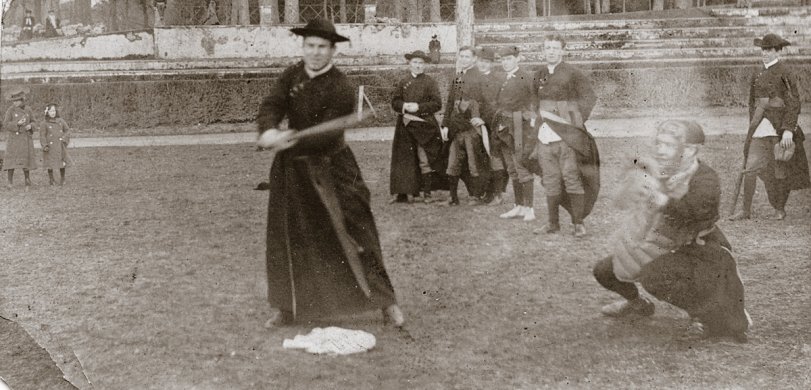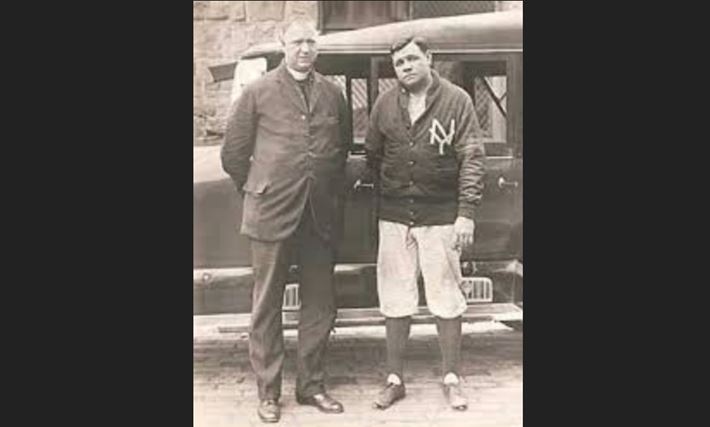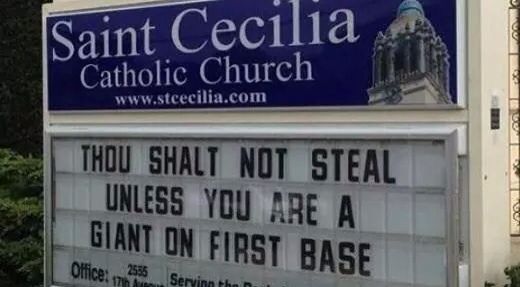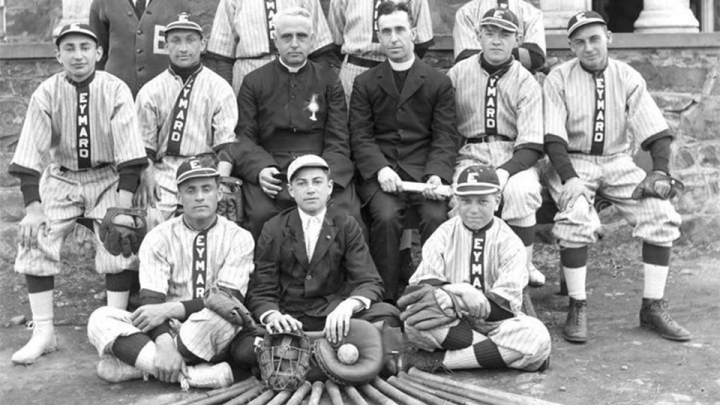And one wonders, maybe even baseball?
Right off the bat (so to speak), Tradition and Order are cornerstones of both Traditional Catholicism and Major League Baseball. That’s a fact. Without ever realizing it, baseball may have borrowed the dual concepts of Tradition and Order from the Catholic Church in forming the most unique team sport in all the world.
In the classic 1989 film, “Field Of Dreams,” the James Earl Jones character, Terrence Mann delivers the most memorable line of the movie in his rich baritone saying, “The one constant through all the years, Ray, has been baseball.”
He ends his magnificent soliloquy with, “It reminds us of all that once was good, and that could be again.” That also describes Traditional Catholicism, does it not?
Mann pauses, then adds the words that Traditional Catholics seeking the Traditional Latin Mass and a Traditional Community have found to be true ever since the Second Vatican Council disaster, (If you build it) “Oh people will come, Ray. People will most definitely come.”
When Catholics have “built” the TLM in their community, believers have “definitely come.” Come they have to Holy Mass and in impressive numbers. That is because believers do not come alone. Just as people do at Major League Baseball parks, they bring their large (Catholic) families with them.
So, the Terrance Mann character could also have credibly stated, “The one constant through all the years, Ray, has been the Holy Catholic Church.” Then he might add, “And the gates of hell shall not prevail against it.”
But this comparison is only the beginning of some intriguing connections between Major League Baseball and the Traditional Catholic Church. By design or (more likely) by Catholic influence of Western Civilization, an argument can be made that baseball, in many ways, mimics Catholicism --- Traditional Catholicism, that is.

Background
The origins of American baseball are said to be a combination of Rounder, a game played by children in New England as far back as the 1700’s and Cricket, the well-known British ball game.
Although Abner Doubleday falsely receives credit for inventing the game, the true credit seems to belong to another New Yorker, Alexander Joy Cartwright, a bank clerk, a surveyor and a volunteer firefighter – and a baseball fanatic in the mid-1800’s, according to the Baseball Hall of Fame.
As a founding member and players for the New York Knickerbockers Baseball Club, named after a firehouse in NYC, Mr. Alexander wrote the magnificent, time-tested rules for the fledgling game to distinguish it from Cricket.
The diamond-shaped infield, foul lines, the balk, the three-strike rule and more are all the thoughtful invention of Mr. Cartwright. Like the Catholic Catechism, there was a beauty, a symmetry, a completeness to Mr. Cartwright’s rules that have endured. The rules now set. In 1846, his Knickerbockers played the first official game of baseball against a Cricket team, according to baseball records.
One more fact about Mr. Cartwright. He was a Free Mason. Now, how could a Free Mason incorporate elements of the Traditional Catholic Church into the game he loved? No one really knows. Chalk it up to God’s incomprehensible sense of humor.
What we do know is that immigrant-laden New York City was quite Catholic in the 19th century. At the helm of the Diocese in 1846, New Yorkers were blessed with the dynamic Bishop John Hughes, a fiery Irishman who had legendary clashes with the militant protestants and the ‘No-Nothing’ Party of that City.
Who taught Babe to play baseball? Turns out it was a Catholic. Brother Matthias, at the St. Mary’s Industrial School for Boys in Baltimore.
In fact, His Excellency’s nickname was Dagger John Hughes. With a nickname such as his, he was the subject of many headlines in the New York press. How much 19th century New York Traditional Catholicism ‘rubbed off’ on Mr. Cartwright? We’ll never know.
Leaving that speculation aside, what we know is that the game of baseball is a product of Western Civilization, and Western Civilization is indeed, a product of the Roman Catholic Church, as Professor Woods implies. So, there must be some linkage between the Catholic Church and baseball to acknowledge.
Consider a few remarkable structural similarities between MLB and the Traditional Catholic Church.
1. Ad Orientum
As good Catholics know, the Altar always faces east, at least liturgical east in Catholic churches. The priest prays the Mass always towards to east, the direction in which Our Redeemer will return.
Similarly, but for a different reason, at every major league park, home plate always, always faces east. The field is not so oriented for the Son of God, but rather it is so oriented for the ‘sun of God’ – to have minimum impact on the sun glaring into players’ eyes when the ball is hit into the air.
Still, home plate facing east is a ‘dogma’ – such a ‘dogma’ in baseball’s history that it even popularized the well-know colloquialism: southpaw, describing a left-handed pitcher. The term southpaw began being connected to baseball as far back as 1858 in the New York Atlas newspaper. With the pitcher facing (west) towards home plate, his right hand would be on the north side of the pitcher’s mound and his left hand (or paw) would be on the south side. Hence, southpaw.
The amazing Babe Ruth was himself a southpaw. And who taught Babe to play baseball? Turns out it was indeed a Catholic. Brother Matthias, at the St. Mary’s Industrial School for Boys in Baltimore, where young Babe was sent for being a “juvenile delinquent” taught him the sport. The good 6’6”, 260 lb. Brother schooled the slugger on how to play the game, including The Babe’s famous uppercut swing!
 Babe Ruth and Brother Matthias
Babe Ruth and Brother Matthias
2. Sacred Music & The Organ
Sacred Music in baseball, really?
That’s a stretch. Baseball music, to the extent it is music at all, is much closer to the Novus Ordo Music Rite. One is more likely to hear renditions of Disney tunes at the baseball games and the Novus Ordo Missa than they are at a Traditional Mass. Who knows. They may be doing The Wave at the Novus Ordo these days.
But hold on. Think of it this way: Go to any TLM or any MLB game and what musical instrument will you hear? Both the Traditional Catholic Rite and MLB games both employ organ music for their ritual.
Chant and polyphony music enjoy pride of place in the Holy Sacrifice of the Mass. And, where one finds Sacred Music, one usually finds an organ. In a sense, baseball does have its own secular version of sacred music. And, it’s invariably played on an organ in virtually every major league baseball park in America. Traditional Catholics should feel right at home.
According to Charles Euchner of the Baseball Hall of Fame, “Music has blended into baseball’s life since 1858, when “The Base Ball Polka” was played at games of the Niagara Base Ball Club.”
“In the early days (of baseball), fans brought sheet music and organized group singing, similar to soccer fans around the world who still sing and chant their songs to rally their clubs and rile the opposition. Before the end of the 19th century, brass bands found their way into the stands, and just prior to World War II, teams began hiring organists to provide a music back-story to games,” Euchner wrote.
Polka music and brass bands did not endure; what has endured since 1941 is the National Anthem always being played before each game on an organ at the ballpark. And, Take Me Out To the Ball Game being played even earlier than 1941, always during the seventh inning stretch.
The same music being played on an organ, at the same events, in the same structured timing, in the same type of eastern-oriented venues. Could it be that the game itself, born in Western Civilization during a very Catholic period of world history, inadvertently borrowed from the Holy Mass? Don’t know. But there is no denying, organ music is a tradition in every MLB park in the land.
3. Coming Home
The object of baseball is to come home and to get as many as possible to come home with you; to cross over, to cross home plate. Coming home: what could be a better image for a man-made team sport. By contrast, the object of every other team sport is to score – a touchdown, a goal, a basket, a point!
In George Carlin’s brilliant comedy routine on the differences between baseball and football, Mr. Carlin comments, “In football the object is for the quarterback, also known as the field general, to be on target with his aerial assault, riddling the defense by hitting his receivers with deadly accuracy in spite of the blitz, even if he has to use shotgun.”
“With short bullet passes and long bombs, he marches his troops into enemy territory, balancing this aerial assault with a sustained ground attack that punches holes in the forward wall of the enemy's defensive line.”
“In baseball the object is to go home! And to be safe! - I hope I'll be safe at home!”
Likewise, our life’s goal is to “go home” to cross over, to return to Our Father and to bring as many believers along with us as possible.
What would you reckon has always been the purpose of man and the Holy Catholic Church? The St. Joseph Baltimore (Children’s) Catechism, under The Purpose Of Man’s Existence answers this way: “God made us to live with Him in His happy home in heaven.”

4. "No One Knows the Day or the Hour"
How much time do we have to get “home” to Heaven? Baseball mirrors the answer to that question. Baseball is the only major team sporting event not to be limited by a clock. What a refreshing metaphysical concept that truly is.
There are no 15-minute quarters, no 20-minute periods in baseball. Each team receives its full nine innings of at-bats. There is no arbitrary clock. It does not matter if the score is 2-1 or 20-1, there is no time restriction. Therefore, no one knows when it will end. In fact, if the teams are tied after nine innings of play, the contest will go into extra-innings. No one knows when it will end!
A century ago, the Brooklyn Robins and the Boston Braves played 26 innings in the longest major league game ever. In 1974, the St. Louis Cardinals and the New York Mets played a 25-inning game. Likewise, in 1984 the Chicago White Sox and the Milwaukee Brewers battled for 25 innings.
But the record goes to a Triple-A game between the Pawtucket Red Sox and the Rochester Red Wings – 33 innings in all! Talk about your Easter Vigil. The game began on Holy Saturday night in 1981 and was halted at 4:07 on Easter morning, with the score knotted at 2-2! The game was later completed in just 18 minutes in mid-June. The Red Sox won 3-2. Our Lord must indeed be a baseball fan. Happy Easter!
So, is it not the same with our faith journey in the Traditional Catholic Church? In the struggles and obstacles we encounter in traversing our path “home,” Our Heavenly Father allows some contests to go on longer than others in the journey back home to Him; sometimes even 33 innings in a nine-inning life.
LATEST FROM REMNANT TV: REALITY CHECK: NO RELIGIOUS EXEMPTIONS? (The Pfizer/Abortion Connection)
5. It Is So Ordered
One does not have to look very far to discover that the TLM and the MLB field are anchored not just in tradition, but also in “Order.” One of example of this order is expressed in the Sanctuary of the church and in the field of play.
There are specifics for the Altar, the Tabernacle, candle placement, vestments – all of it and much more are ordered in a certain configuration.
The MLB field is likewise precisely ordered.
The field is always a diamond configuration. The front of the pitching rubber must be specifically 60 feet 6 inches from the apex (point) of home plate. Not 60 feet, not 61 feet, but 60 feet 6 inches. It has been 60 feet 6 inches since 1893. The top of the pitching rubber is always 10 inches above home plate.
The bases are 90 feet apart, not a nice round number such as 100, but 90. And, it has been the way since 1840! Order and Tradition all rolled into one, as the game of baseball unintentionally mimics Traditional Catholicism.
Legendary sportswriter Red Smith once opined, “Ninety feet between bases is perhaps as close as man ever comes to perfection.” Mr. Smith’s phrase “as close as man ever comes to perfection” has real theological overtones, does it not?
And who is responsible for maintaining such precise order?
In baseball, it is the umpire. In the Traditional Church, it is the traditional Catholic priest. Incidentally, both are always clad in black. The order that traditional Catholic priests bring to this world is blatantly observable by Catholics and non-Catholics alike. After all, the powerful Sacrament they receive is actually called Holy Orders.
These holy priests provide us with the boundaries of life. They help us understand God’s rule books, such as the Bible and the Catechism. Where would Western Civilization be without the teaching and preaching of holy priests? (We have begun to see it in this current Modernist, pagan era)
Like the umpire, the holy priest confidently “makes the call.” Likewise, they do not shy away from making the right call.
Poorly-formed managers are likened to poorly-formed priests. They are a serious obstacle to being successful in reaching our goal.
Certainly there are poorly-formed umpires and poorly-formed priests who make the wrong call. The poorly-formed umpire may intentionally call a runner out who is safe at first base. The poorly-formed priests may make the call that it is acceptable for abortion-promoters such as Nancy Pelosi or Joe Biden to receive Holy Communion. Or, a priest in the Vatican may make a bad call by foisting documents such as Traditionis Custodes on good Catholics in order to sow confusion and animosity.
Bad umpires and bad priests no longer bring order. Instead, they foster chaos, confusion and untruths.
Order, right order, is critical in secular baseball and in Traditional Catholicism.
6. Who Sets The Line-Up?
Bestowed upon these men by Our Dear Lord, the awesome responsibility of a traditional priest cannot be limited, by comparison, to the role of just an umpire on the baseball diamond. Well-formed priests bring order in other ways.
In the great game of baseball, priestly duties are also aped by a good manager. Both the traditional priest and the baseball manager lead us on the best way to come “home:” to be successful, to reach our final sought-after destination.
One could easily hear a manager or a priest addressing their respective flock with these words, “We are making too many errors out there. What I have observed is that we have all become way too complacent. These errors can put in jeopardy our ultimate goal. How do we solve this? We must renew our internal focus! When we’re out there, we must concentrate on the good and minimize the bad.”
A prime duty of the manager is that he sets the line-up for individuals and for the team to maximize their success. Another phrase for line-up is batting order.
Legendary player Ty Cobb has the highest batting average of those in the Hall at .344. Although most impressive, it means that Mr. Cobb failed to hit safely 65.6% of his at-bats. This baseball saint, the best of the lot, failed to do the good nearly two-thirds of the time!
The priest likewise sets the line-up – the line-up of Holy Mass, Confession, Adoration, processions, the holy Rosary and more in their parish to optimize the laity’s performance before God. For example, how many times a week does the priest scheduled Confessions? From this line-up, priests coach us individually (often times in the Confessional) and from the pulpit on how we should be performing; how to make it to our home in Heaven.
Poorly-formed managers are likened to poorly-formed priests. They are a serious obstacle to being successful in reaching our goal.
7. Of Saints and Stars
The Church has Her Saints. Baseball has its Hall of Fame. What can we learn from this?
Individuals in this class are inspirational figures. They deserve to be studied, representing the good that has come before us. They are verifiable proof that it is indeed possible for us to reach the heights. They provide a blueprint on how it is done.
Traditional Catholics and the MLB have commonality in this regard.
Excellence is a common denominator with these people. Also in common, there is no such evidence of perfection. (one exception: Our Blessed Mother) They, were, as are we, flawed. Yet, they demonstrate to us how, flaws and all, we can also attain our goal. In our case, our heavenly goal.
In this light, the baseball Hall of Fame is especially instructive. Legendary player Ty Cobb has the highest batting average of those in the Hall at .344. Although most impressive, it means that Mr. Cobb failed to hit safely 65.6% of his at-bats. This baseball saint, the best of the lot, failed to do the good nearly two-thirds of the time!
There is demonstrable proof that Traditional Catholics understand this equation intimately. One only needs to come early to a TLM and behold the long lines for the Confessional.
In the Modernist world of 2021, Terrance Mann’s words apply more to Traditional Catholicism than they do to baseball, “It reminds us of all that once was good, and that could be again.”
Unite the Clans. Keep the Faith! And, oh yeah, enjoy the World Series.


